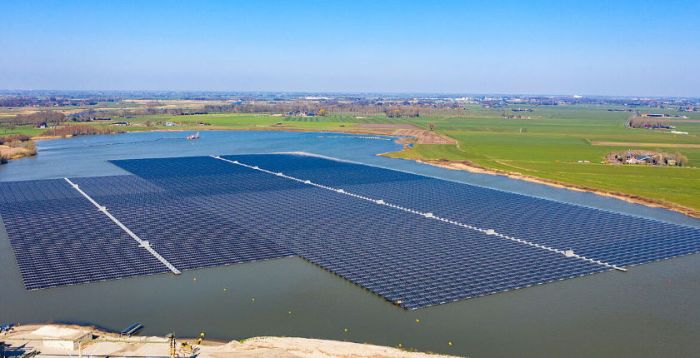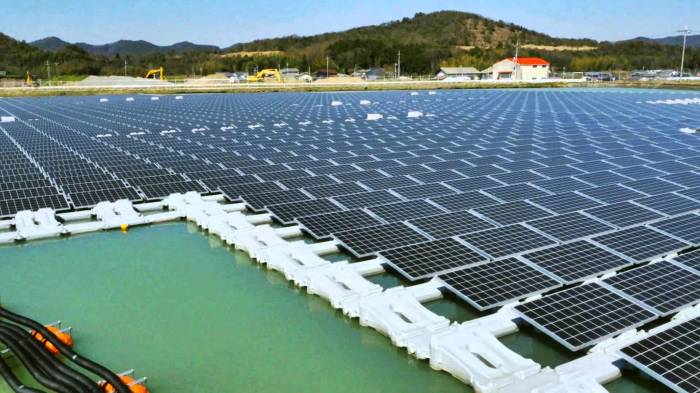Kyocera’s Floating Solar Plant
Harnessing the power of the sun on water, Kyocera’s floating solar plant represents a groundbreaking innovation in renewable energy. This cutting-edge technology offers a sustainable solution for maximizing solar energy generation while minimizing land use and environmental impact.
Kyocera’s Floating Solar Plant: A Technological Innovation
Floating solar plants are photovoltaic systems installed on platforms that float on water bodies, such as lakes, reservoirs, and even coastal areas. These installations offer several advantages over traditional land-based solar farms, including:
* Increased Land Efficiency: Floating solar plants utilize otherwise unused water surfaces, freeing up valuable land for other purposes.
* Improved Energy Production: Water’s cooling effect can enhance solar panel efficiency, leading to higher energy yields.
* Reduced Water Evaporation: Floating solar panels can create a shade barrier, reducing water evaporation and conserving water resources.
* Mitigation of Water Contamination: By blocking sunlight, floating solar panels can inhibit the growth of algae and other aquatic weeds, promoting cleaner water.
Kyocera’s Role in Floating Solar Technology
Kyocera, a global leader in solar energy solutions, has been at the forefront of developing and deploying floating solar technology. The company has a rich history of innovation in the solar industry, dating back to the 1970s. Kyocera’s commitment to sustainability and technological advancement has led to the development of high-performance floating solar systems that are reliable, efficient, and environmentally friendly.
Key Features and Specifications of Kyocera’s Floating Solar Plant
Kyocera’s floating solar plant is designed with several key features and specifications:
* High-Efficiency Solar Panels: Kyocera utilizes its advanced solar panel technology to maximize energy generation. The panels are engineered for optimal performance and long-term durability.
* Robust Floating Platform: The platform is constructed from high-quality materials, ensuring stability and resistance to harsh weather conditions.
* Modular Design: The modular design allows for flexible configurations and scalability, enabling the plant to be adapted to various water bodies and power requirements.
* Advanced Monitoring System: The plant is equipped with a comprehensive monitoring system that provides real-time data on performance, maintenance, and environmental conditions.
Comparison with Other Floating Solar Projects, Kyocera reveals floating solar plant
Kyocera’s floating solar plant stands out from other similar projects in the industry due to its:
* Proven Track Record: Kyocera has a long history of developing and deploying successful solar projects, demonstrating its expertise and reliability.
* Innovative Technology: Kyocera’s floating solar plant incorporates advanced technologies, such as high-efficiency solar panels and robust floating platforms.
* Environmental Sustainability: Kyocera prioritizes environmental sustainability in all its projects, ensuring minimal impact on the surrounding ecosystem.
- Example: Kyocera’s floating solar plant in Japan, located on a reservoir, generates enough electricity to power over 1,000 homes.
Environmental Impact and Sustainability
Kyocera’s floating solar plant stands as a testament to the potential of renewable energy to mitigate environmental impact and foster sustainable practices. This innovative project harnesses the power of the sun while minimizing its footprint on the surrounding ecosystem.
Renewable Energy Generation and Carbon Reduction
The floating solar plant significantly contributes to the generation of clean energy, reducing reliance on fossil fuels and their associated emissions. By converting sunlight into electricity, the plant helps decrease greenhouse gas emissions, contributing to the fight against climate change. The plant’s ability to generate clean energy reduces the need for traditional power plants, which often rely on fossil fuels, leading to a significant reduction in carbon emissions.
Minimizing Ecological Footprint and Responsible Resource Utilization
The project’s design minimizes its ecological footprint by utilizing existing water bodies, such as reservoirs or lakes, without encroaching on valuable land. The floating panels also provide shade, helping to regulate water temperature and improve water quality. This responsible resource utilization ensures that the project minimizes its impact on the surrounding environment and promotes sustainable practices.
Long-Term Benefits of Floating Solar Technology
Floating solar technology offers a sustainable and scalable solution for clean energy production. The long-term benefits of this technology extend beyond immediate carbon reduction and include:
- Enhanced Water Quality: The shade provided by the floating panels helps regulate water temperature, reducing algal blooms and improving water quality.
- Reduced Land Use: By utilizing existing water bodies, floating solar plants minimize the need for land-based solar installations, preserving valuable land for other purposes.
- Increased Energy Efficiency: Floating solar panels often benefit from cooler water temperatures, leading to increased energy efficiency compared to land-based installations.
- Resilience to Natural Disasters: Floating solar plants are less susceptible to natural disasters like wildfires and floods, ensuring a more reliable source of energy.
Economic and Social Benefits
Kyocera’s floating solar plant offers a compelling blend of economic and social benefits, contributing to both local communities and the broader energy landscape. This innovative project demonstrates the potential of floating solar technology to create jobs, attract investment, and enhance energy security while promoting environmental sustainability.
Economic Benefits
The economic benefits of Kyocera’s floating solar plant extend beyond the immediate project scope, influencing local communities and the broader economy.
- Job Creation: The construction, operation, and maintenance of the floating solar plant generate numerous job opportunities in various sectors, including engineering, construction, and renewable energy management. This creates employment opportunities for local residents, contributing to economic growth and development.
- Investment Opportunities: The project attracts significant investment in renewable energy infrastructure, fostering economic activity and stimulating further investment in the region. The presence of such a large-scale project attracts investors seeking opportunities in the growing clean energy sector.
- Local Economic Development: The plant’s operation boosts local businesses, creating demand for goods and services, and stimulating economic activity in the surrounding area. The project can also serve as a catalyst for further development, attracting additional businesses and industries to the region.
Social Impact
The social impact of Kyocera’s floating solar plant extends beyond economic benefits, addressing critical concerns related to energy security, affordability, and community well-being.
- Energy Security: The project enhances energy security by diversifying energy sources and reducing reliance on fossil fuels. The floating solar plant provides a reliable and sustainable source of electricity, mitigating the risks associated with energy supply disruptions.
- Energy Affordability: The project promotes energy affordability by reducing reliance on fossil fuels, which are subject to price fluctuations. The solar plant generates clean and cost-effective electricity, benefiting both consumers and businesses.
- Community Well-being: The project contributes to community well-being by promoting environmental sustainability and improving air quality. By reducing greenhouse gas emissions, the plant contributes to a healthier environment and a better quality of life for local residents.
Potential for Remote and Water-Abundant Regions
Kyocera’s floating solar plant highlights the potential of this technology to address energy challenges in remote or water-abundant regions.
- Remote Regions: Floating solar plants can be deployed in remote areas with limited land availability, providing access to clean energy in regions where traditional solar installations are not feasible. This can be particularly beneficial for communities lacking access to reliable electricity.
- Water-Abundant Regions: Floating solar plants can be deployed on large water bodies, such as lakes, reservoirs, and coastal areas, maximizing land use and minimizing environmental impact. This technology can be especially effective in regions with abundant water resources, allowing for large-scale solar power generation.
Technological Advancements and Future Outlook: Kyocera Reveals Floating Solar Plant
Kyocera’s floating solar plant is a testament to the rapid advancements in solar technology, showcasing the potential of this renewable energy source to address global energy needs. The plant’s successful implementation is attributed to several key technological breakthroughs, paving the way for a more sustainable future.
Key Technological Advancements
The development of Kyocera’s floating solar plant has been driven by several key technological advancements:
- Advanced Solar Panel Design: Kyocera’s solar panels are engineered for high efficiency and durability, capable of withstanding harsh weather conditions and prolonged exposure to water. These panels are designed to maximize energy production, even in challenging environments.
- Floating Platform Technology: The development of robust and adaptable floating platforms has enabled the deployment of solar panels on water bodies. These platforms are designed to withstand waves, currents, and other environmental factors, ensuring the stability and safety of the solar array.
- Smart Monitoring and Control Systems: Advanced monitoring and control systems are integrated into the floating solar plant, allowing for real-time performance tracking, predictive maintenance, and remote management. These systems ensure optimal operation and minimize downtime.
- Integration with Existing Infrastructure: Kyocera’s floating solar plant is designed to seamlessly integrate with existing power grids, enabling efficient energy distribution and minimizing the need for new infrastructure development.
Future Potential of Floating Solar Technology
Floating solar technology holds immense potential for various sectors and geographical locations:
- Large-Scale Power Generation: Floating solar farms can be deployed on vast water bodies like reservoirs, lakes, and oceans, providing a significant source of clean energy for large populations.
- Land-Scarce Regions: In areas with limited land availability, floating solar offers a viable alternative to traditional land-based solar installations, allowing for the development of renewable energy sources without encroaching on valuable land.
- Water Conservation and Management: Floating solar panels can reduce water evaporation from reservoirs, contributing to water conservation efforts. The shading provided by the panels can also help to regulate water temperatures, benefiting aquatic ecosystems.
- Coastal and Offshore Applications: Floating solar technology can be deployed in coastal and offshore areas, harnessing the abundant sunlight and reducing the reliance on fossil fuels for power generation.
Ongoing Research and Development
Research and development efforts in the field of floating solar energy are continuously advancing, focusing on:
- Enhanced Panel Efficiency: Researchers are developing more efficient solar panels with improved light absorption and energy conversion capabilities, leading to increased energy production from floating solar farms.
- Improved Platform Design: Innovations in platform design are focused on enhancing stability, durability, and adaptability to diverse environmental conditions, enabling the deployment of floating solar farms in challenging locations.
- Integration with Other Renewable Technologies: Research is exploring the integration of floating solar with other renewable energy sources, such as wind and wave energy, creating hybrid systems that provide more reliable and sustainable energy solutions.
Kyocera reveals floating solar plant – As Kyocera’s floating solar plant takes center stage, it signifies a paradigm shift in how we approach renewable energy. The project not only showcases the potential of floating solar technology but also highlights the growing importance of sustainable energy solutions. By embracing innovation and pushing the boundaries of clean energy, Kyocera is paving the way for a future powered by the sun.
Kyocera’s announcement of a floating solar plant is a cool move, showing how we can harness energy in innovative ways. It’s a bit like how the battlefield hardline final resolution for xbox one ps4 confirmed gave gamers a clearer picture of the game’s visual fidelity, this floating solar plant is a clear sign of the future of sustainable energy.
 Standi Techno News
Standi Techno News

